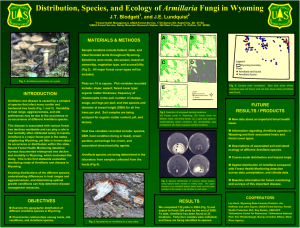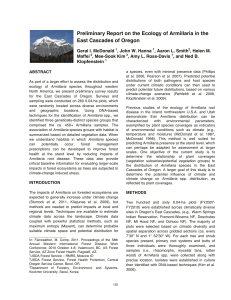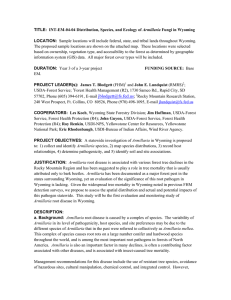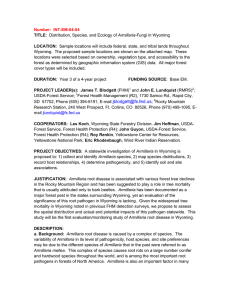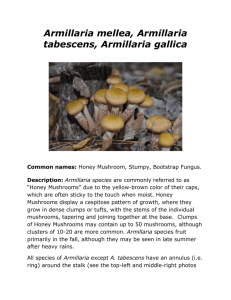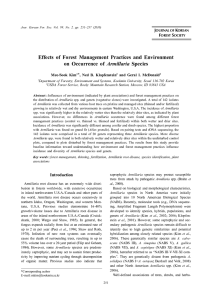Preliminary Report on the Ecology of Armillaria in the
advertisement
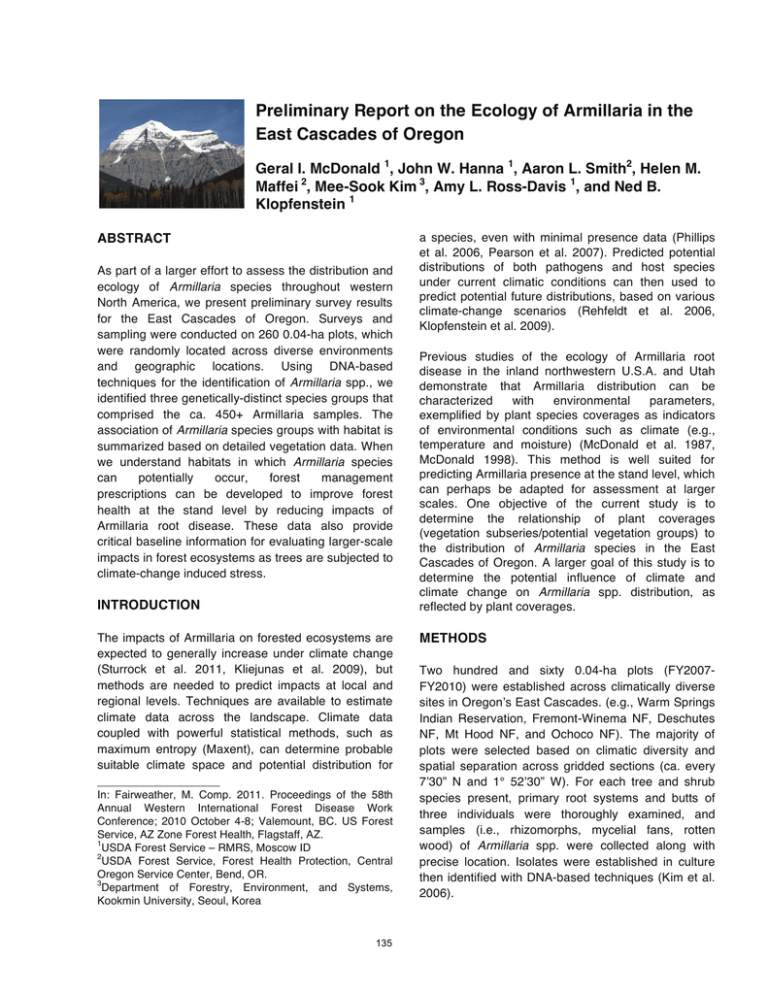
! Preliminary Report on the Ecology of Armillaria in the East Cascades of Oregon Geral I. McDonald 1, John W. Hanna 1, Aaron L. Smith2, Helen M. Maffei 2, Mee-Sook Kim 3, Amy L. Ross-Davis 1, and Ned B. Klopfenstein 1 ABSTRACT a species, even with minimal presence data (Phillips et al. 2006, Pearson et al. 2007). Predicted potential distributions of both pathogens and host species under current climatic conditions can then used to predict potential future distributions, based on various climate-change scenarios (Rehfeldt et al. 2006, Klopfenstein et al. 2009). As part of a larger effort to assess the distribution and ecology of Armillaria species throughout western North America, we present preliminary survey results for the East Cascades of Oregon. Surveys and sampling were conducted on 260 0.04-ha plots, which were randomly located across diverse environments and geographic locations. Using DNA-based techniques for the identification of Armillaria spp., we identified three genetically-distinct species groups that comprised the ca. 450+ Armillaria samples. The association of Armillaria species groups with habitat is summarized based on detailed vegetation data. When we understand habitats in which Armillaria species can potentially occur, forest management prescriptions can be developed to improve forest health at the stand level by reducing impacts of Armillaria root disease. These data also provide critical baseline information for evaluating larger-scale impacts in forest ecosystems as trees are subjected to climate-change induced stress. Previous studies of the ecology of Armillaria root disease in the inland northwestern U.S.A. and Utah demonstrate that Armillaria distribution can be characterized with environmental parameters, exemplified by plant species coverages as indicators of environmental conditions such as climate (e.g., temperature and moisture) (McDonald et al. 1987, McDonald 1998). This method is well suited for predicting Armillaria presence at the stand level, which can perhaps be adapted for assessment at larger scales. One objective of the current study is to determine the relationship of plant coverages (vegetation subseries/potential vegetation groups) to the distribution of Armillaria species in the East Cascades of Oregon. A larger goal of this study is to determine the potential influence of climate and climate change on Armillaria spp. distribution, as reflected by plant coverages. INTRODUCTION METHODS The impacts of Armillaria on forested ecosystems are expected to generally increase under climate change (Sturrock et al. 2011, Kliejunas et al. 2009), but methods are needed to predict impacts at local and regional levels. Techniques are available to estimate climate data across the landscape. Climate data coupled with powerful statistical methods, such as maximum entropy (Maxent), can determine probable suitable climate space and potential distribution for Two hundred and sixty 0.04-ha plots (FY2007FY2010) were established across climatically diverse sites in Oregonʼs East Cascades. (e.g., Warm Springs Indian Reservation, Fremont-Winema NF, Deschutes NF, Mt Hood NF, and Ochoco NF). The majority of plots were selected based on climatic diversity and spatial separation across gridded sections (ca. every 7ʼ30” N and 1° 52ʼ30” W). For each tree and shrub species present, primary root systems and butts of three individuals were thoroughly examined, and samples (i.e., rhizomorphs, mycelial fans, rotten wood) of Armillaria spp. were collected along with precise location. Isolates were established in culture then identified with DNA-based techniques (Kim et al. 2006). ____________________ In: Fairweather, M. Comp. 2011. Proceedings of the 58th Annual Western International Forest Disease Work Conference; 2010 October 4-8; Valemount, BC. US Forest Service, AZ Zone Forest Health, Flagstaff, AZ. 1 USDA Forest Service – RMRS, Moscow ID 2 USDA Forest Service, Forest Health Protection, Central Oregon Service Center, Bend, OR. 3 Department of Forestry, Environment, and Systems, Kookmin University, Seoul, Korea ! ! ! KEY FINDINGS (1) Armillaria spp. are common in the East Cascades of Oregon, occurring on 56 percent of 260 sampled plots. Armillaria incidence increases to 73 percent, when 95 of the driest, wettest, warmest, and coolest plots are excluded (table 1). (2) Among the three Armillaria species groups identified, NABS X group was collected from the greatest range of climates as inferred from vegetation subseries. Armillaria solidipes group was rarely found on the warmest sites and the NABS III-V-VII (A. calvescens-A. sinapina-A. gallica) complex was rarely found on the coolest sites (tables 2-4). Figure 1—Cedar Hemlock/Moist Herb potential vegetation group, a highly suitable site for Armillaria. DISCUSSION Ecological assessments of Armillaria are critical to address forest management needs. Habitat-based predictions of Armillaria distributions are useful for stand-level Armillaria risk assessments, such as the Armillaria Response Tool (ART) (McDonald et al. 2005). These stand-level indicators can be combined with climate-based predictions of Armillaria distributions at a much larger scale (Klopfenstein et al. 2009), which can be adapted for future predictions under various climate-change scenarios. Future predictions of both pathogens and hosts can provide information for National Insect and Disease Risk Maps. Climate-based predictions will continue to improve as higher resolution grids are developed that include influences of slope, aspect, and soil types. In addition, molecular techniques will also continue to improve species identification and allow classification of genetic diversity at the subspecies level, which will allow further refinements in predictions of environmental influences (Kim et al. 2006, Hanna et al. 2007, Ross-Davis et al. this volume). The plant coverages on each plot were classified into vegetation subseries/potential vegetation groups. Each subseries/group represents several ecologically similar plant associations/habitat types based on the percent coverage of key indicator plants (McDonald 1998). RESULTS Armillaria spp. were found on 146 plots (56.1 percent) of the 260 plots surveyed. Armillaria solidipes (= A. ostoyae) was found on 33 plots (12.7 percent), North American Biological Species (NABS) III-V-VII (A. calvescens-A. sinapina-A. gallica complex) was found on 73 plots (28.1 percent), and NABS X (including NABS X hybrids with NABS III/V/VII) was found on 67 plots (25.8 percent). Table 1—Occurrence of all Armillaria spp. in the East Cascades of Oregon. Dry Grass Dry Shrub Dry Herb Wet Herb Wet Forb West Shrub 0/0 Pinyon Juniper 0/1 Ponderosa pine 4/42 3/15 0/0 Douglas-fir 0/0 0/3 5/7 0/0 Cool pine 0/5 3/3 1/1 0/0 0/1 2/2 0/0 0/0 Cedar Hemlock ! Moist Herb Cool fir 0/0 72/105 35/46 7/7 0/0 0/0 Cold fir 1/2 5/9 6/7 2/3 0/1 0/0 ! 0/0 ! Table 2—Occurrence of Armillaria solidipes in the East Cascades of Oregon. Dry Grass Dry Shrub Dry Herb Moist Herb Wet Herb Wet Forb West Shrub 0/0 Pinyon Juniper 0/1 Ponderosa pine 1/42 0/15 0/0 Douglas-fir 0/0 0/3 0/7 0/0 Cool pine 0/5 1/3 1/1 0/0 0/1 1/2 0/0 0/0 Cedar Hemlock Cool fir 0/0 10/105 12/46 2/7 0/0 0/0 Cold fir 1/2 3/9 1/7 0/3 0/1 0/0 0/0 Table 3—Occurrence of North American Biological Species (NABS) III-V-VII (Armillaria calvescens, A. sinapina, A. gallica) in the East Cascades of Oregon. Dry Grass Dry Shrub Dry Herb Moist Herb Wet Herb Wet Forb West Shrub 0/0 Pinyon Juniper 0/1 Ponderosa pine 1/42 2/15 0/0 Douglas-fir 0/0 0/3 4/7 0/0 Cool pine 0/5 0/3 0/1 0/0 0/1 1/2 0/0 0/0 Cedar Hemlock Cool fir 0/0 44/105 19/46 1/7 0/0 0/0 Cold fir 0/2 0/9 1/7 0/3 0/1 0/0 0/0 Table 4—Occurrence of North American Biological Species (NABS) X or hybrids of NABS X with NABS III-V-VII (Armillaria calvescens, A. sinapina, A. gallica). Dry Grass Dry Shrub Dry Herb Wet Herb Wet Forb West Shrub 0/0 Pinyon Juniper 0/1 Ponderosa pine 2/42 1/15 0/0 Douglas-fir 0/0 0/3 1/7 0/0 Cool pine 0/5 2/3 0/1 0/0 0/1 1/2 0/0 0/0 Cedar Hemlock ! Moist Herb Cool fir 0/0 29/105 16/46 6/7 0/0 0/0 Cold fir 0/2 2/9 5/7 2/3 0/1 0/0 ! 0/0 ! REFERENCES Rehfeldt, G.E., Crookston, N.L., Warwell, M.V., Evans, J.S. 2006. Empirical Analyses of plant-climate relationships for the western United States. Int. J. Plant Sci. 167:1123-1150 Ross-Davis, A.L., Klopfenstein, N.B., Hanna, J.W. forthcoming. Molecular-based identification and phylogeny th of North American Armillaria species. In: Proceedings 58 Annual Western International Forest Disease Work Conference, October 4-8, 2010, Valemount, B.C. Sturrock, R.N., Frankel, S.J., Brown, A.V., Hennon, P.E., Kliejunas, J.T., Lewis, K.J., Worrall, J.J., Woods, AJ. 2011. Climate change and forest diseases. Plant Pathology 60:133-149. Hanna, J.W., Klopfenstein, N.B., Kim, M.-S., McDonald, G.I., Moore, J.A. 2007. Phylogeographic patterns of Armillaria ostoyae in the western United States. Forest Pathology 37:192-216. Kim, M.-S., Klopfenstein, N.B., Hanna, J.W., McDonald, G.I. 2006. Characterization of North American Armillaria species: Genetic relationships determined by ribosomal DNA sequences and AFLP markers. Forest Pathology 36:145-164. Kliejunas, J.T., Geils, B., Glaeser, J.M., Goheen, E.M., Hennon, P., Kim, M-S., Kope, H., Stone, J., Sturrock, R., Frankel, S. 2009. Climate and forest diseases of western North America: a literature review. Albany, CA. USDA, Forest Service, Pacific Southwest Research Station. 36 p. Klopfenstein, N.B., Kim, M.-S., Hanna, J.W., Richardson, B.A., Lundquist, J.E. 2009. Approaches to predicting potential impacts of climate change on forest disease: an example with Armillaria root disease. Res. Pap. RMRS-RP76. Fort Collins, CO: USDA, Forest Service, Rocky Mountain Research Station. 10 p. McDonald, G.I. 1998. Preliminary report on the ecology of Armillaria in Utah and the inland west. In Proceedings of th the 46 Annual Western International Forest Disease Work Conference, Compiled by L. Trummer. USDA Forest Service, Region 10 State and Private Forestry, Anchorage, AK. p. 85-92. McDonald, G.I., Martin, N.E., Harvey, A.E. 1987. Occurrence of Armillaria spp. in forests of the Northern Rocky Mountains. Res. Pap. INT-381. Ogden, UT: USDA, Forest Service, Intermountain Research Station. 7 p. McDonald, G.I., Tanimoto, P.D., Rice, T.M., Hall, D.E., Stewart, J.E., Zambino, P.J., Tonn, J.R., Klopfenstein, N.B., Kim, M.-S. 2005. Fuels planning: science synthesis and integration; environmental consequences fact sheet 13: Root Disease Analyzer-Armillaria Response Tool (ART) RMRS-RN-23-13WWW. Fort Collins, CO: USDA, Rocky Mountain Research Station. 2 p. Pearson, R.G., Raxworthy, C.J., Nakamura, M., Townsend Peterson, A. 2006. Predicting species distributions from small numbers of occurrence records: a test case using cryptic geckos in Madagascar. Journal of Biogeography. 34:102-117. Phillips, S.J., Anderson, R.P., Schapire, R.E. 2006. Maximum entropy modeling of species geographic distributions. Ecological Modeling. 190:231-259 ! ! Proceedings of the 58th Annual Western International Forest Disease Work Conference October 4-8, 2010 Valemount, British Columbia Proceedings of the 58th Annual Western International Forest Disease Work Conference October 4-8, 2010 Valemount, British Columbia Best Western Valemount Compiled by: Mary Lou Fairweather Forest Health Protection Flagstaff, AZ and Patsy Palacios S.J. and Jessie E. Quinney Natural Resources Research Library College of Natural Resources Utah State University, Logan ©2011, WIFDWC These proceedings are not a vailable for cita tion of publication without consent of the authors. Papers are formatted and ha ve minor editing for language, and style, but otherwise are printed as the y were submitted. The authors are responsible for content.
